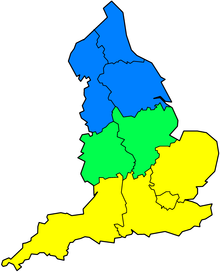South coast of England
|
Southern England South of England |
|
|---|---|
| Nickname(s): The South | |
 In this image, Southern England and East Anglia is shown as yellow, Northern England as blue, and The Midlands as green |
|
| Sovereign state | United Kingdom |
| Country | England |
| Largest settlements | |
| Area | |
| • Total | 23,955 sq mi (62,042 km2) |
| Population (2011) | |
| • Total | 27,945,000 |
| Time zone | GMT (UTC) |
| • Summer (DST) | BST (UTC+1) |
Southern England, or the South of England, also known as the South, refers roughly to the southern counties of England. The extent of this area can take a number of different interpretations depending on the context, including geographical, cultural, political and economic.
Geographically, the extent of the south of England may vary from the southern one-third of the country (excluding central England), to the southern half, bordering northern England. The South is often considered a principal cultural area of England, along with the Midlands and Northern England. Many consider the area to have a distinct identity from the rest of England, however without universal agreement on what cultural, political, and economic characteristics of the South are.
For statistical purposes, Southern England is divided into four regions: South West England, South East England, London, and the East of England. Combined, these have a total area of 62,042 square kilometres (23,955 sq mi), and a population of 28 million.
People often apply the term "southern" loosely, without deeper consideration of the geographical identities of Southern England. This can cause confusion over the depth of affiliation between its areas. As in much of the rest of England, people tend to have a deeper affiliation to their county or city. Thus, residents of Essex are unlikely to feel much affinity with people in Oxfordshire. Similarly, there is a strong distinction between natives of the south-west and south-east.
The sport of rugby experienced a schism in 1895 with many teams based in Yorkshire, Lancashire and surrounding areas breaking from the Rugby Football Union and forming their own League. The disagreement that led to the split was over the issue of professional payments, and "broken time" or injury payments. There is a perception that league is the code of rugby played in the north, whilst union is the code played in the south.
...
Wikipedia
